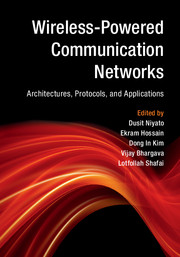Preface
Published online by Cambridge University Press: 01 December 2016
Summary
Recently, there has been an upsurge of research interest in wireless-powered communication networks. These networks are based on energy harvesting and/or energy transfer technology, for mobile devices using wireless propagation media. This technology offers the capability of using different types of wireless medium, such as radio frequency and magnetic induction, to carry energy from dedicated sources to wireless nodes or to harvest energy from ambient sources. Therefore, this has become a promising solution to power energy-constrained wireless networks. Conventionally, energy-constrained wireless networks such as wireless sensor networks have a limited lifetime, which leads to significant deterioration in network performance and usability. By contrast, a network with wireless energy harvesting and transfer capability can be powered without using a fixed power supply. For example, it can harvest energy from environmental sources such as solar and wind energy or from other dedicated or non-dedicated sources which are tetherless. Hence, there is no need to charge or replace the batteries physically, which can improve the flexibility and availability of the network substantially. Wireless energy has many advantages over other energy sources, including indoor support and stable and more predictable supply.
There are three major types of wireless energy harvesting and transfer technique, namely, radio frequency (RF), inductive coupling, and magnetic resonance coupling techniques. In RF energy harvesting, radio signals with frequencies in the range from 3 kHz to 300 GHz are used as a medium to carry energy in the form of electromagnetic radiation. Inductive coupling is based on magnetic coupling that delivers electrical energy between two coils tuned to resonate at the same frequency. The electric power is carried through the magnetic field between two coils. Magnetic resonance coupling utilizes evanescent-wave coupling to generate and transfer electrical energy between two resonators. The resonator is formed by adding a capacitance on an induction coil. Inductive coupling and magnetic resonance coupling are near-field wireless transmission techniques featuring high power density and conversion efficiency. By contrast, RF energy transfer can be regarded as a far-field energy transfer technique. It is suitable for powering a larger number of devices distributed over a wide area. Wireless energy harvesting and transfer have found many applications and have recently been implemented in many devices, including mobile phones, healthcare devices, sensors, and RFID tags.
- Type
- Chapter
- Information
- Wireless-Powered Communication NetworksArchitectures, Protocols, and Applications, pp. xi - xivPublisher: Cambridge University PressPrint publication year: 2016



